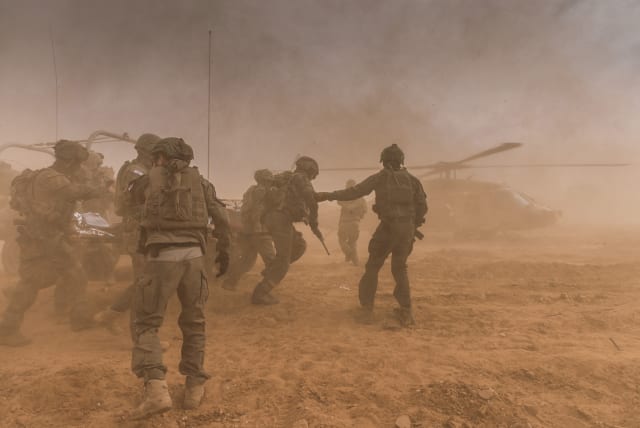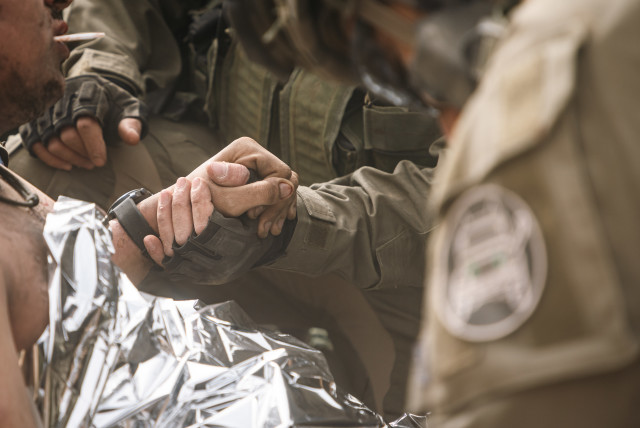IDF achieves unprecedented medical evacuation times

These quick turnaround times not only help the patients, but lower risk to the ground forces and evacuation forces, as well as help the soldiers preoccupied with the injured get back to the fight.
In recent evacuations of soldiers from the Gaza Strip, it has taken an average of 27 minutes from the moment a soldier is wounded until he is in a helicopter on the way to hospital, said Lt.-Col. N., commander of a team within the IAF command cell responsible for evacuating wounded soldiers.
In these recent instances, it has taken about 40 minutes from the moment a soldier is wounded until he is in the operating room, he added.
Overall, under the direction of the command cell, it has taken an average of 47 minutes until a helicopter lifts off with the wounded soldier, which is unprecedented, he said.
“If you live in Tel Aviv, it takes longer to order a pizza than for a wounded person to get a helicopter in Gaza,” N. said.“Before the war, we would train to have a helicopter on the ground for one minute to load patients and take off,” he said. “There were helicopters in the [Gaza] war that managed to load a wounded person and take off in less than 15 seconds.”
Because time is so critical, the evacuation team is always pushing to be faster, N. said.
“If we do it in 40 minutes, we will examine how we can do it in 35,” he said. “When we get to 35, we will see how we can do it in 25. When we get to 20, we will ask, Why not 19? There is no optimum that would satisfy us.”
The clock is ticking on the best patient outcome
These quick turnaround times not only help the patients, they lower risk to the ground forces and evacuation forces, as well as help the soldiers preoccupied with the wounded get back to the fight, N. said.
Regarding a seriously wounded soldier, every minute is important, N. said, adding that there are patients who “without an airborne evacuation would not be with us today. Many dozens of such combat soldiers” were evacuated and saved by the command cell.
N. said he works with a large team of experts, each from a different discipline and responsible to give advice on how best to evacuate any given patient.
N. said he consults with some of Israel’s most senior doctors, who help advise and coordinate what hospital a patient should be sent to.
N. recalled one case in which a soldier had both arms amputated, but there was a storm over the hospital best equipped to handle the situation, and the helicopter could not land there. One of the doctors who works with N. called another doctor on the phone and set everything in motion to ensure that the patient would receive the care he needed at a hospital where it was safe to land.
The cell has tragically had a lot of practice in the war, with about 1,200 wounded from maneuvers in Gaza alone, N. said, adding that there is risk involved in every evacuation.
“There are almost no places in the Gaza Strip we have not landed, from open ground, which has challenges, to the centers of cities, like Khan Yunis,” N. said.
The cell works hard to minimize the risk on every mission, he said.
Home Front Command’s medical command center is responsible for directing medical evacuation flights to the correct hospital.
Maj. Tamar Galili is the officer in charge of the command center, which is operational 24/7 in war and in peacetime. The center is tasked with managing medical emergencies on the home front, but it is currently mostly working to provide support for IDF maneuvers.
“The process starts with us getting a report from the IAF on the situation and the status on the ground,” she said. “From the moment we are involved, we create a complete picture, coordinating with the relevant command, the Medical Corps, and the IAF.”
Galili said her command center choses two sites for every evacuation – a primary site and a shortcut site. The primary site is always a hospital that is defined by the Health Ministry as a center that can handle any patient, she said. The shortcut site may not be able to handle every wound as well as the primary site, but it is closer.
“If the doctor in the helicopter decides that the patient is in a very, very complex medical situation, and he must land now to get to the hospital immediately, he will go to the closet hospital,” Galili said.
Her center then updates the hospital on exactly what they are getting, such as how many helicopters and how many wounded – anything that can make their absorption smoother.
Galili has contributed to the war effort through her service and also at home. She let a unit in the South that needed a place to stay for three months use her house.
“My whole house was full of mattresses and the soldiers’ gear,” Galili said.
“At the same time I was [in the command center] and managing the whole medical field of Home Front Command, I was also supporting the maneuver from the other side,” she said.
Galili said her parents and siblings fed the soldiers in the unit and did their laundry. They even celebrated Hanukkah together.
“We are not from the Gaza [periphery communities], but we live in the South,” she said. “It was important to us as a family to feel that we were a part of this incredible thing,” regarding the contribution of Israeli civilians to the war.
Galili touched on the difficulties involved in being part of a command center that is helping wounded people.“It’s hard and challenging, but the meaning of knowing why, and always having that reason in front of us, gives us strength and allows us to stay ready,” she said.
N. also touched on something that helps keep his spirits high through his challenging role – his reserve duty soldiers.“Am Yisrael is lucky to have these people every single day,” he said.
N. said the reserve soldiers who make up a huge and significant part of his team are “inspiring and worth appreciating.”•
Jerusalem Post Store
`; document.getElementById("linkPremium").innerHTML = cont; var divWithLink = document.getElementById("premium-link"); if (divWithLink !== null && divWithLink !== 'undefined') { divWithLink.style.border = "solid 1px #cb0f3e"; divWithLink.style.textAlign = "center"; divWithLink.style.marginBottom = "15px"; divWithLink.style.marginTop = "15px"; divWithLink.style.width = "100%"; divWithLink.style.backgroundColor = "#122952"; divWithLink.style.color = "#ffffff"; divWithLink.style.lineHeight = "1.5"; } } (function (v, i) { });

